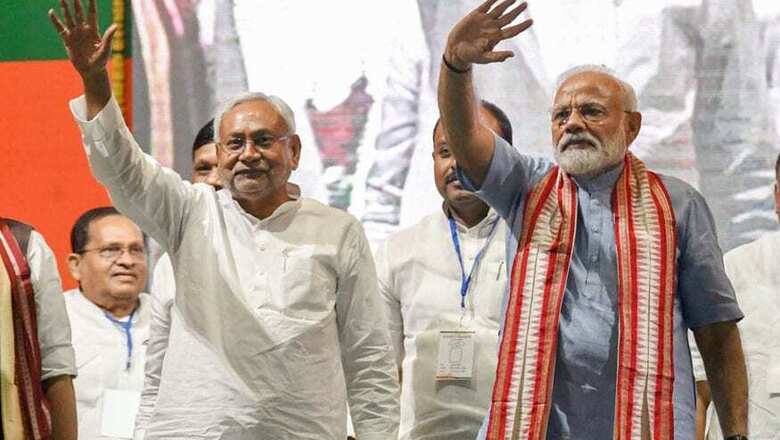
views
Patna: Despite breaking off with erstwhile allies and joining hands with the BJP post last polls, the move doesn't seem to have impacted chief minister Nitish Kumar's image as majority of the exit polls have predicted victory for the NDA in Bihar.
According to News18 IPSOS exit poll, the National Democratic Alliance will get 34-36 seats, while the UPA will get four-six seats.
Other surveys like Chanakya-News 24 has predicted 32 seats for the BJP and eight seats for the Congress; ABP Neilsen says BJP will get 34 seats and six seats will go to Congress. According to the Republic C-Voter, NDA will win 33 seats with JDU and LJP winning 20 seats and BJP 13 seats. UPA is expected to win seven seats with RJD winning five seats, Congress two, and others none.
Bihar’s Lok Sabha election results hinge on two prominent factors: the acid test of Chief Minister Nitish Kumar’s image after joining hands with the BJP as part of the National Democratic Alliance (NDA) and the extent to which Rashtriya Janata Dal (RJD) chief Tejashwi Yadav was able to mobilise the caste-matrix in the absence of his father and former chief minister Lalu Prasad.
With JD(U), BJP and LJP allying in the state, the grand opposition consisted of RJD, Jitan Ram Manjhi-led Hindustani Awam Morcha (HAM), Congress, Upendra Kushwaha–led Rashtriya Lok Samata Party and Mukesh Sahni-led Vikasheel Insaan party.
The BJP in the last Lok Sabh elections won 32 seats in the state. What could have made the aspired road to victory difficult for the opposition was Nitish Kumar’s grip on the backward castes in a state that sends 40 lawmakers to the Lok Sabha.
The RJD, on the other hand, tried to consolidate non-Yadav OBC votes and is, for the first time, contesting less than 25 seats as it hoped that its smaller allies, which hold sway over some OBC voters, would help it secure more votes.
Caste was a major factor in the selection of candidates as both sides were well aware of caste-based polling patterns in the state. NDA focused on the political combination of upper castes (BJP), non-Yadav OBCs, and particularly MBC votes (JDU) and Paswan votes (LJP).
RJD, on the other hand, hoped to expand its social base (political equation of Muslim-Yadav) with the help of its smaller allies like former chief minister Jitan Ram Manjhi-headed HAM (Maha Dalits), former union minister Upendra Prasad-headed RLSP (Kushwaha) and VIP (Nishad).
This was also for the first time that Bihar moved to polls without Lalu Prasad. The RJD head, convicted in the fodder scam, is in jail.
Apart from caste, national security seemed to work in BJP’s favour across the state as the RJD found it difficult to counter the NDA on issues such as Pulwama attacks and Pakistan. The opposition chose to focus on unemployment, demand for special status to Bihar and promises made by Modi in the 2014 LS and the 2015 assembly polls.
Although the RJD had opposed the Centre’s decision to implement the upper castes’ quota, it failed to develop it as a poll issue in the absence of Lalu.
NDA throughout its campaigns also highlighted schemes like Ayushman Bharat, Ujjwala and construction of toilets. Nitish’s development agenda, particularly the availability of bijali, sadak and pani even in the remotest areas helped the NDA avoid local factors from becoming major poll issues.
Bihar has six major regions — Bhojpur, Champaran, Mithilanchal, Seemanchal, Kosi and Magadh-Pataliputra, most of which witnessed slight rise in voter turnout, more so for women.
Experts opine that may have worked in NDA’s favour given the legacy of Nitish Kumar apparently having an undivided constituency of women.
Apart from the veterans, Kanhaiya Kumar, a candidate for CPI(M) in Begusarai drew considerable attention. As per the ABP Neilsen’s poll survey he is expected to lose this battle. BJP’s Giriraj Singh was forced to shift from his traditional seat of Nawada to fight the former JNU student union leader. RJD’s Tanveer Hassan contested from the same seat. He had lost by a thin margin during a Modi wave in 2014 Lok Sabha polls.
Union minister RK Singh was the BJP nominee from Ara. CPI(ML), which got this seat in its share in the Grand Alliance, had fielded Raju Yadav. HAM, an ally of the Grand Alliance, contested two seats — Gaya and Aurangabad. Manjhi represented Imamganj assembly seat, which was part of Aurangabad.
HAM’s performance in this region was supposed to be politically significant for the 2020 state assembly polls as well. The Grand Alliance’s strategy in Aurangabad was to make a dent into the Kushwaha votes, which has traditionally showed a tilt towards the NDA.
The urban seats in Bihar were also poised for an interesting battle.
This region had two prominent seats under Patna district — Patna Sahib and Pataliputra. Patna Sahib, from where union minister Ravi Shankar Prasad was contesting, is considered to be a BJP stronghold. He was pitted against Shatrughan Sinha, fielded by the Congress after his switch from the BJP.
Apart from Patna Sahib, Pataliputra Lok Sabha seat was important because RJD chief Lalu Prasad’s daughter and Rajya Sabha member Misa Bharti was her party’s nominee against BJP leader and Union minister Ram Kripal Yadav, an erstwhile close aide of Lalu.
In a battle of caste versus image, Bihar’s Lok Sabha election was very different from what it has seen before.
















Comments
0 comment